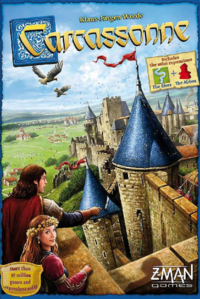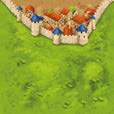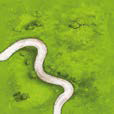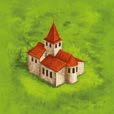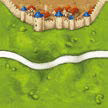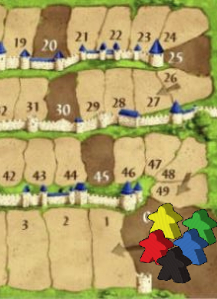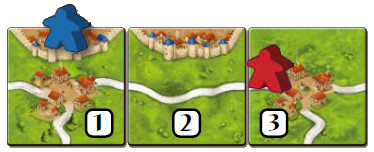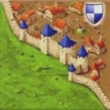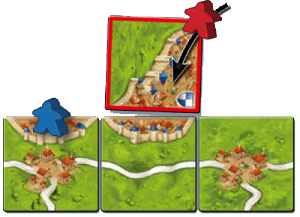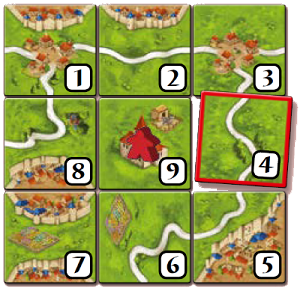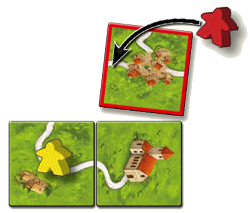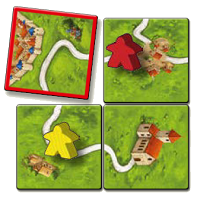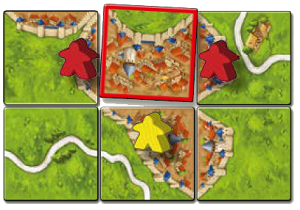Base game
General info and comments
Carcassonne, the world-famous French city, is known for its imposing fortifications erected during Antiquity and the Middle Ages. This fortress, surrounded by magnificent walls, still stands today as one of the most unique French cities. In this game, players must develop the area around Carcassonne. They place their followers onto roads and into cities, monasteries, and fields. Only those who make the most judicious placements will gain the points required to win the game.
Info on farmers rules
Farmers are considered a part of the base game for most Carcassonne players. They are also used in every official tournament as they are not considered an expansion. In the new edition of Carcassonne farmers were separated as a supplement to ease access to the game for new players. WikiCarpedia follows this streamlined approach. For the sake of other expansions and the rest of the WikiCarpedia, farmers are considered a part of the base game. You can find farmers rules here The_Farmers.
Components and setup
To begin, we need is setup, which will also introduce you to the components of the game.
The 72 LANDSCAPE TILES show roads, cities, and monasteries, in a field.
The backs of all the tiles are the same, but the START TILE has a darker colored back, so you can recognize it easily. Other graphical elements such as houses, people, or animals have no impact on the game[1].
Place the start tile (the one with a dark back) in the middle of the table. Shuffle the remaining tiles and set them as different facedown stacks that are easily accessible to all players.
Then comes the scoreboard, which you set to the side of your playing surface (table, floor, etc.).
Finally, we have the meeples. You will find in the box 40 regular meeples, including 8 meeples in each of these colors: yellow, red, green, blue, and black. In addition, there are also 5 abbots[2], including 1 in each of the same colors.
Start by distributing 7 meeples of the color of their choice to each player. These meeples constitute each player’s personal supply. Each player takes seven meeples of their chosen color to form their supply. Place each player's eighth meeple on the 0 space on the scoreboard. These will be used to track each player's score throughout the game.
Overview and goal of the game
In Carcassonne, players take turns placing tiles and expanding the landscape of roads, cities, monasteries and fields, one tile at a time. Players may place their meeples on the individual features of tiles as well (roads, cities, monasteries, and fields), where they will become highwaymen, knights, monks, and farmers. Points are earned throughout the game, and the player with the highest score at the end is the winner!
Gameplay
A game of Carcassonne is played in clockwise order. Starting with the first player, the current player does the following actions in the order listed below, after which it is the next player’s turn, and so on and so forth. First, we’ll give you a brief description of the actions you have to do during one of your turns. These actions will be detailed as we present the roads, the cities, and finally the monasteries. So what are these actions?
- Placing a tile: The player must draw exactly 1 Land tile from a stack and place it faceup to continue the landscape.
- Placing a meeple: The player may place a meeple from their supply onto the tile they have just placed.
- Scoring a feature: The player must score any feature completed by the tile placement.
The roads
Placing a tile
Placing a meeple as highwayman
After placing the tile, you may place a meeple as a highwayman on one of that tile’s road segments, but only if the road is unoccupied by another highwayman.
In our example, since the road is not yet completed, no scoring occurs (see action 3) and play moves on to the next player.
The next player draws a tile that he/she places to continue the landscape. They may not place a meeple on the road to the right since your highwayman is already present on that road. Instead, they choose to place their meeple as a knight in the city segment of that tile.
Scoring a road
When both ends of a road are closed, that road is completed and scored. The end of a road is closed when it meets a village, a city, a monastery, or it loops onto itself by meeting the other end. So let’s see if there is a scoring here... Huzzah! There is one because both ends of the road are closed.
Even though it is your opponent that placed the tile, this still completes your road. How many points do you score? When scoring a road, each tile of that road grants you 1 point. Here, since you scored a road that is made out of 3 tiles, you score 3 points. Well done!
It is now time to note your score. You keep track of your score with the meeple you placed on the scoreboard before starting the game. Continuing our example, you move it forward 3 spaces to show that you’ve scored 3 points. Note: if your score passes 50 points, lay down your scoring meeple to show your 50+ points. After each scoring, return to your supply the meeple that was just scored.
That’s it! We’ve already seen the most important parts of the game. Now, we will further expand on those actions by showing you how they apply to the other features, namely the cities and the monasteries:
The cities
Placing a tile
Placing a meeple as a knight
Scoring a city
Let’s continue our example and assume that a few turns have passed. You now draw this tile that you place to continue your city. Since the tile you’ve placed completes a feature (here, the city), it must now be scored. A city is completed when it is surrounded by walls and there are no gaps inside the city. Since you have a meeple in the completed city, you are the player to score it.
Each tile in a completed city is worth 2 points. In addition, each coat of arms is worth 2 more points. For this city, you score 8 points! As usual, the meeple that was in the scored feature returns to your supply.
The monasteries
Placing a tile
Placing a meeple as a monk
Scoring a monastery
A monastery is completed when it is surrounded by tiles. During scoring, the monastery is worth 1 point per tile that completes it (including the monastery itself).
Perfect! By placing this tile, you complete your monastery. It earns you 9 points and allows you to take your meeple back.
And voilà! We have already seen most of the rules for Carcassonne. There are only a few points left to see, but first, here is a summary of what we’ve seen so far:
Summary
Placing a tile
- You must place your drawn tile in such a way that it continues the landscape and the illustration.
- In some very rare cases, it may be impossible to place the tile. In those cases, simply return the tile to the box and draw a new one.
Placing a meeple
- You may place a meeple on the tile you’ve just placed.
- You may not place a meeple in a feature where there already is at least one other meeple.
Scoring a feature
- A road is completed when both ends lead to a village, a city, a monastery, or the road forms a loop. Each tile in a completed road is worth 1 point.
- A city is completed when it is surrounded by walls and there are no holes inside the city. Each tile in the completed city is worth 2 points. Each coat of arms in the completed city is worth an extra 2 points.
- A monastery is completed when it is surrounded by 8 tiles. Each of the monastery’s tiles (the 8 surrounding tiles and the one with the monastery itself) is worth 1 point.
- Scoring always occurs at the end of a player’s turn. At that moment, each player with a meeple in a scored feature earns points.
- After each scoring, return to your supply the scored meeples.
- If there are multiple meeples in a single scored feature, the player with the most meeples is awarded full points and all other players receive nothing. When more than one player have the most meeples in a scored feature, the tied players all score full points.
Game end and final scoring
Sadly, all good things must come to an end, and the same goes for a game of Carcassonne. You may wish that it were otherwise, but there must be a winner! Thus, the game ends immediately after the turn of the player who placed the last tile. Then, players proceed to a final scoring, after which the winner will be known to all!
Once the game is over, all meeples still in play are scored:
- Each incomplete road is worth 1 point per tile, just like during the game.
- Each incomplete city is worth 1 point per tile and 1 point per coat of arms, which is only half the points.
- Each incomplete monastery is worth 1 point plus 1 point per adjacent tile, just like during the game.
- Each field is worth 3 points per adjacent completed city.
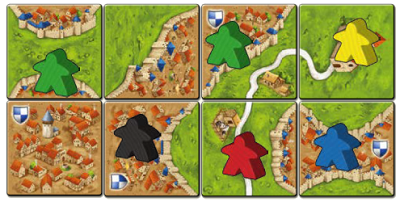
Final scoring - monastery: Yellow scores 4 points for this incomplete monastery (3 points for the adjacent tiles and 1 point for the monastery itself).
Final scoring - city: Blue scores 3 points for this incomplete city (2 tiles and 1 coat of arms).
Final scoring - road: Red scores 3 points for this incomplete roads (3 tiles).
Once the final score is known, the winner is the player with the most points. Congratulations on winning your first game of Carcassonne!
Many meeples in the same feature
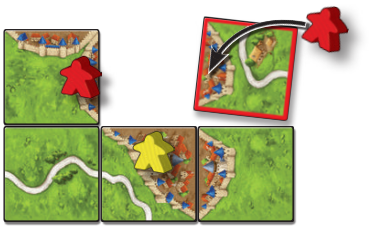
Use a Meeple, Score a Feature, and Get the Meeple Back
You can place a meeple in a feature you just completed, immediately score it, and then return the meeple to your supply. to be filled
Footnotes
For Icons explanation and licensing please visit Icons page.
- ↑ They have no impact considering the base rules. They are or in some case probably will be used in expansions. For example The_Markets_of_Leipzig
- ↑ Usage of abbots is described in The Abbot mini expansion page
